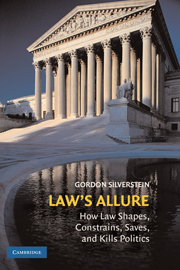Book contents
- Frontmatter
- Contents
- Acknowledgments
- LAW'S ALLURE
- Introduction: Law's Allure: The Juridification of American Politics and Public Policy
- PART I LAW'S ALLURE: WHY, WHY NOW, AND WHY IT MATTERS
- PART II LAW'S ALLURE: PATTERNS, PROCESS, AND CAUTIONARY TALES
- 4 Poverty and Abortion: The Risks and Rewards of a Judicial Strategy
- 5 Environmental Regulation: A Constructive Pattern
- 6 Campaign Finance: A Deconstructive Pattern
- 7 The Separation of Powers: When the Court Says Yes – and No
- 8 War Powers and Precedent: When the Court Is Reluctant to Intervene
- PART III LAW'S ALLURE: COSTS AND CONSEQUENCES
- Conclusion: The Promise and Peril of Law's Allure
- Bibliography
- Index
- References
4 - Poverty and Abortion: The Risks and Rewards of a Judicial Strategy
Published online by Cambridge University Press: 05 June 2012
- Frontmatter
- Contents
- Acknowledgments
- LAW'S ALLURE
- Introduction: Law's Allure: The Juridification of American Politics and Public Policy
- PART I LAW'S ALLURE: WHY, WHY NOW, AND WHY IT MATTERS
- PART II LAW'S ALLURE: PATTERNS, PROCESS, AND CAUTIONARY TALES
- 4 Poverty and Abortion: The Risks and Rewards of a Judicial Strategy
- 5 Environmental Regulation: A Constructive Pattern
- 6 Campaign Finance: A Deconstructive Pattern
- 7 The Separation of Powers: When the Court Says Yes – and No
- 8 War Powers and Precedent: When the Court Is Reluctant to Intervene
- PART III LAW'S ALLURE: COSTS AND CONSEQUENCES
- Conclusion: The Promise and Peril of Law's Allure
- Bibliography
- Index
- References
Summary
Juridification comes in two basic flavors: attempts to accomplish policy and political goals by relying on judicial decisions and attempts to reform, control, automate, proceduralize, formalize, and depoliticize political institutions, politics, and the political process itself. Each involves courts and judicial rulings to some degree. Sometimes, these rulings shape choices by saying no. Sometimes, the courts together with the elected branches engage in something like a game of leap-frog, with each jump moving the players along an unpredictable path, in which legislation builds on judicial rulings and the next round of judicial rulings pivot on the previous round of legislation. Poverty and abortion are cases in which the law and the courts seemed to offer a substitute for the political process. The motives and incentives in these cases, however, were different, as were the results. Although the juridification of abortion was very much an example of relying on the court's classical blocking function, juridification in the poverty case was an early and ultimately unsuccessful effort to use the Court's new command function to work around a political process that had lost its appeal.
Poverty and the Allure of the Court's Commands
Brown v. Board of Education and Baker v. Carr paved what seemed a more efficient, more effective, even morally superior path for advocates and entrepreneurs to follow in pursuit of their policy goals. And policy advocates, entrepreneurs, and a small army of young, low-paid, progressive lawyers were ready to march down that path.
- Type
- Chapter
- Information
- Law's AllureHow Law Shapes, Constrains, Saves, and Kills Politics, pp. 95 - 127Publisher: Cambridge University PressPrint publication year: 2009



